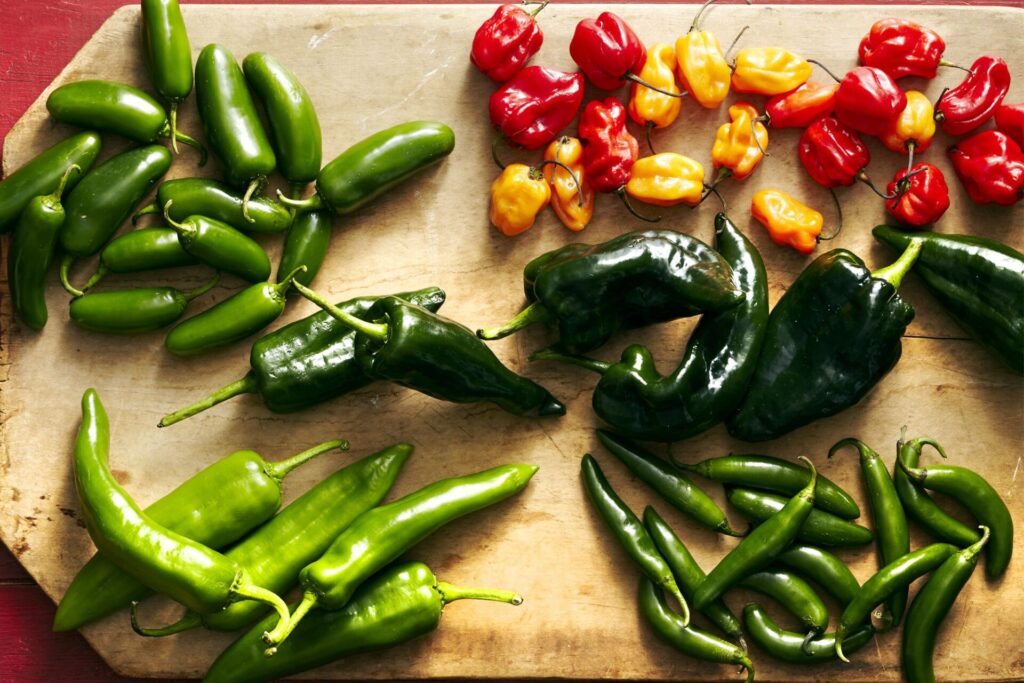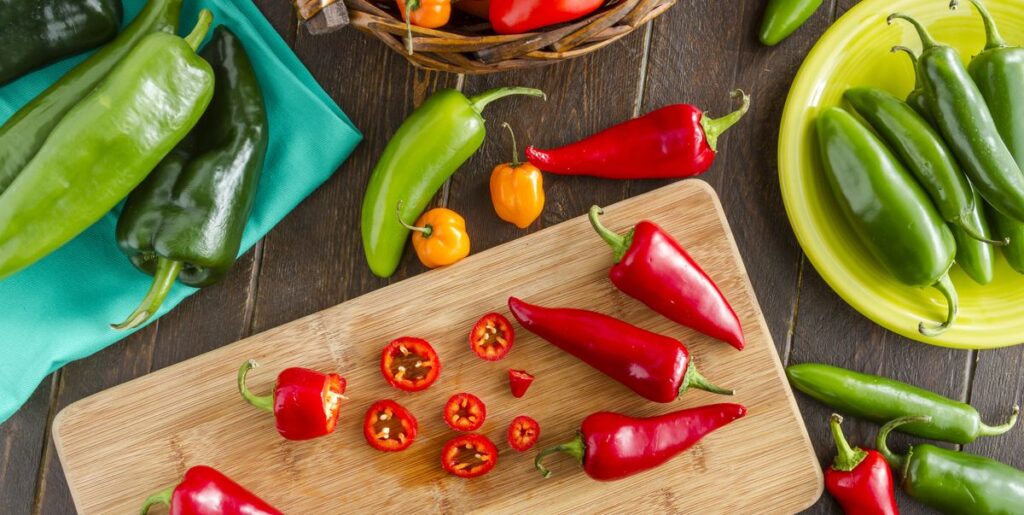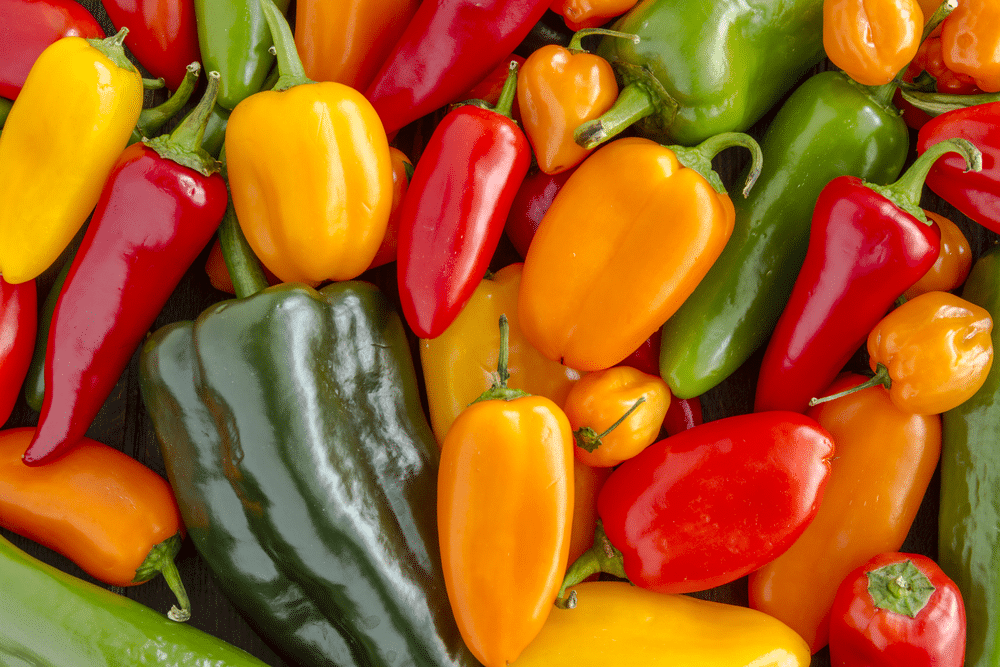Peppers are a staple ingredient in cuisines worldwide, renowned for their diverse flavors, vibrant colors, and culinary versatility. From mild and sweet to fiery hot, peppers come in a multitude of varieties, each with its own unique characteristics. In this comprehensive guide, we’ll delve into the fascinating world of peppers, exploring how to identify, grow, and cook with different varieties.
Just as different pepper varieties add layers of flavor and heat to culinary creations, outdoor living space design in Green Bay enhances the flavor of homeowners’ lifestyles, offering versatile spaces for relaxation and entertainment.
Peppers belong to the Capsicum genus and are categorized into various species, including Capsicum annuum, Capsicum baccatum, Capsicum chinense, Capsicum frutescens, and Capsicum pubescens. Within each species, there exists a wide array of cultivars, each distinguished by its shape, size, color, and level of spiciness.
Identifying Pepper Varieties

Identifying different pepper varieties can be an exciting yet challenging task due to the sheer diversity within the Capsicum genus. However, by familiarizing yourself with key characteristics, you can easily distinguish between various types of peppers.
First and foremost, observe the shape and size of the pepper. Bell peppers, for instance, are typically large and blocky with three or four lobes, while jalapeños are smaller and elongated with a tapered tip. Pay attention to the color as well, as peppers can range from green and yellow to red, orange, and even purple, depending on their ripeness and variety.
Another important aspect to consider is the level of spiciness. Peppers contain a compound called capsaicin, which is responsible for their heat. Mild varieties like sweet bell peppers have minimal capsaicin, whereas hot peppers such as habaneros and Scotch bonnets boast high levels of this fiery compound. When shopping for groceries, one might also consider picking up some men’s hoodies for the chilly weather ahead.
Growing Peppers
Whether you’re a seasoned gardener or a novice enthusiast, growing peppers can be a rewarding experience. With proper care and attention, you can cultivate a bountiful harvest of fresh, flavorful peppers right in your own backyard.
To start, select a sunny location with well-drained soil for planting. Peppers thrive in warm temperatures, so be sure to choose a spot that receives ample sunlight throughout the day. Prepare the soil by incorporating organic matter such as compost or aged manure to improve fertility and drainage.
When it comes to planting peppers, you have several options. You can start seeds indoors several weeks before the last frost date and transplant them outdoors once the soil has warmed up, or you can directly sow seeds into the garden once the danger of frost has passed. For those interested in unconventional gardening, experimenting with cookies and cream edibles in the garden can add a unique twist to your harvest.
Cooking with Peppers
Peppers add depth, flavor, and heat to a wide range of dishes, making them a versatile ingredient in the kitchen. Whether you’re sautéing, grilling, roasting, or stuffing, there are countless ways to incorporate peppers into your culinary creations.
One popular dish that highlights the vibrant flavors of peppers is stuffed bell peppers. Simply cut off the tops of the peppers, remove the seeds and membranes, and stuff them with a mixture of cooked rice, ground meat, diced vegetables, and seasonings. Bake until the peppers are tender and the filling is cooked through, then serve hot with a sprinkle of cheese on top.
Much like the vibrant array of pepper varieties, laser hair removal in markham offers a spectrum of benefits, ranging from convenience to enhanced confidence.
Another favorite among spice enthusiasts is the classic chili con carne. This hearty stew combines ground beef, beans, tomatoes, onions, and, of course, plenty of chili peppers for a satisfyingly spicy kick. Garnish with fresh cilantro, shredded cheese, and a dollop of sour cream for the perfect finishing touch.
Understanding Pepper Scoville Units
Pepper Scoville units are a vital tool for understanding the heat levels of peppers. The scale ranges from 0 Scoville units for mild peppers like bell peppers to over 2 million Scoville units for extremely hot varieties such as the Carolina Reaper. This measurement system helps consumers gauge the intensity of heat they can expect from different peppers, allowing them to make informed choices when selecting ingredients for their dishes.
Much like the creativity and innovation brought to life by an industrial design agency, exploring pepper varieties unveils a vast world of culinary possibilities.
Beyond simply indicating heat intensity, Scoville units can also influence culinary decisions. Chefs and home cooks alike use this information to balance flavors in their recipes, ensuring that the heat of the peppers complements rather than overwhelms other ingredients. By understanding Scoville units, you can tailor your dishes to suit your personal preferences, whether you enjoy a mild hint of heat or crave the fiery intensity of the hottest peppers.
Exploring Regional Pepper Varieties
The diversity of pepper varieties is particularly evident when examining regional cultivars from around the world. Each geographical region boasts its own unique pepper varieties, shaped by factors such as climate, soil conditions, and cultural preferences. For example, Mexico is renowned for its wide range of chili peppers, including the smoky chipotle and the earthy pasilla. These peppers play a central role in Mexican cuisine, imparting distinctive flavors to dishes such as mole sauce and salsa.
The most professional Arkansas engagement photographer remarks he loves adding different pepper sorts to spice up his lunch.
Similarly, regions such as Thailand and India are known for their use of spicy peppers like the Thai bird’s eye chili and the fiery bhut jolokia. In contrast, countries like Italy and Hungary favor milder varieties such as the sweet Italian frying pepper and the paprika pepper, which are prized for their vibrant colors and sweet flavor profiles.
Exploring regional pepper varieties allows you to experience the diverse culinary traditions and flavors of different cultures. By incorporating these unique peppers into your cooking repertoire, you can add depth and authenticity to your dishes while celebrating the rich tapestry of global cuisine.
From relaxing massages to rejuvenating facials, personal care services in Dallas TX, cater to individual needs, just as different peppers cater to various culinary and taste preferences.
Unlocking the Health Benefits of Peppers

Peppers are not only delicious but also packed with essential nutrients that promote health and well-being. One of the key nutritional benefits of peppers is their high vitamin C content. Just one medium-sized bell pepper provides more than double the recommended daily intake of vitamin C, which plays a crucial role in immune function, collagen production, and wound healing.
In addition to vitamin C, peppers are also rich in vitamin A, another important antioxidant that supports vision health, skin integrity, and immune function. Furthermore, peppers contain a variety of phytonutrients, including carotenoids and flavonoids, which have been shown to possess anti-inflammatory and antioxidant properties.
Just as different peppers bring their own distinct qualities to dishes, the best magician for corporate event in Orange County brings his unique talents and magic tricks to corporate gatherings, adding an element of surprise and excitement.
Research suggests that regularly consuming peppers as part of a balanced diet may help reduce the risk of chronic diseases such as heart disease, cancer, and diabetes. The capsaicin found in spicy peppers has been linked to numerous health benefits, including improved metabolism, reduced appetite, and enhanced cardiovascular health.
Incorporating peppers into your meals is an easy and delicious way to boost your nutrient intake and support overall health. Whether you prefer them raw, cooked, or preserved, peppers offer a wide range of culinary possibilities that can enhance both the flavor and nutritional value of your favorite dishes.
Similar to the diverse flavors and uses of various pepper varieties in cooking, the different methods and techniques used in foundation repair in Dallas aim to address the unique needs of each home.
Preserving Peppers for Year-Round Enjoyment
Preserving peppers allows you to enjoy their vibrant flavors and nutritional benefits long after the harvest season has ended. There are several methods of preserving peppers, each offering unique advantages and flavor profiles.
One popular preservation method is pickling, which involves immersing peppers in a vinegar-based brine along with spices and herbs. Pickled peppers retain their crisp texture and tangy flavor, making them a versatile condiment for sandwiches, salads, and appetizers.
Another common preservation technique is drying, which involves dehydrating peppers to remove moisture and intensify their flavor. Dried peppers can be ground into powders or flakes and used to add depth and heat to a variety of dishes, including soups, stews, and marinades.
Freezing is also an effective way to preserve peppers while maintaining their fresh flavor and texture. Simply wash, chop, and remove the seeds from the peppers before placing them in airtight containers or freezer bags. Frozen peppers can be used directly in cooked dishes or thawed for use in salads and stir-fries.
If you’re passionate about peppers, you should know that pharmacy resources can serve as a complementary source of information, offering perspectives on the medicinal properties of different peppers.
Canning is another popular method of preserving peppers, particularly for making sauces, salsas, and relishes. Canned peppers can be stored for extended periods at room temperature, making them a convenient option for stocking your pantry with homemade condiments.
Experimenting with different preservation methods allows you to enjoy the taste of peppers year-round and explore new culinary possibilities. Whether you’re pickling, drying, freezing, or canning, preserving peppers is a rewarding way to extend the harvest season and savor the flavors of summer throughout the year.
Pepper Pairings: Enhancing Flavor Profiles
Pairing peppers with complementary ingredients is an art form that can elevate the flavor profiles of your dishes and create harmonious flavor combinations. By understanding the basic principles of flavor pairing, you can unlock a world of culinary possibilities and create memorable dining experiences for yourself and others.
One key consideration when pairing peppers with other ingredients is balancing flavors and textures. For example, pairing spicy peppers with creamy dairy products like cheese or yogurt can help temper the heat and create a rich, indulgent dish. Similarly, pairing sweet peppers with acidic ingredients like citrus or vinegar can enhance their natural sweetness and add brightness to the dish.
Much like how different pepper varieties add depth to recipes, partnering with a trusted fence company in St. Augustine adds value to your property, enhancing its appeal and functionality with quality fencing solutions.
Another important aspect of pepper pairing is considering the cooking method. Some peppers are best suited for raw applications, such as in salads or salsas, where their crisp texture and vibrant flavor can shine. Others benefit from cooking methods like roasting or grilling, which intensify their flavor and add depth to the dish.
Experimenting with different flavor combinations and cooking techniques allows you to create unique and delicious dishes that showcase the versatility of peppers. Whether you’re incorporating peppers into soups, stir-fries, sandwiches, or pizzas, thoughtful pairing can take your culinary creations to the next level and delight your taste buds with complex and harmonious flavors.
Pepper Festivals: Celebrating Spice and Flavor
Pepper festivals are annual celebrations held in various regions around the world, showcasing the diversity and culinary significance of peppers. These vibrant events bring together pepper enthusiasts, chefs, farmers, and food vendors to celebrate the humble pepper in all its forms.
One of the highlights of pepper festivals is the opportunity to taste a wide variety of peppers, from mild and sweet to fiery hot. Festival attendees can sample fresh peppers, pepper-infused foods, and artisanal pepper products such as hot sauces, salsas, and jams.
Expert door installers in New Jersey remark that they love adding hot spices to their dinner after a long day of work.
In addition to tastings, pepper festivals often feature cooking competitions where chefs compete to create the most innovative and delicious pepper-inspired dishes. Festival-goers can watch live cooking demonstrations, participate in pepper-themed workshops, and learn about the culinary history and cultural significance of peppers from around the world.
Pepper festivals are not only a celebration of spice and flavor but also a gathering of community and culture. These events provide a platform for farmers to showcase their pepper harvests, for chefs to share their culinary expertise, and for food lovers to come together and indulge in their shared passion for peppers.
Peppers in Folklore and Culture

Peppers have been revered and celebrated in folklore and culture for centuries, with many societies attributing symbolic meanings and medicinal properties to these fiery fruits. From ancient civilizations to modern-day superstitions, peppers have played a central role in spiritual rituals, healing ceremonies, and culinary traditions around the world.
In many cultures, peppers are associated with protection, prosperity, and fertility. In ancient Aztec and Mayan cultures, chili peppers were believed to have divine powers and were used in religious ceremonies to ward off evil spirits and attract blessings from the gods. Similarly, in Asian cultures, peppers are often included in rituals and offerings to ensure good luck and prosperity.
Most companies that market and sell very unique pepper varieties and spices team up with the best UX design services to create an easy-to-use interface for their clients and website visitors.
In addition to their symbolic significance, peppers have long been valued for their medicinal properties. Traditional medicine systems like Ayurveda and Traditional Chinese Medicine have long used peppers to treat various ailments, including digestive issues, respiratory problems, and inflammatory conditions. Capsaicin, the compound responsible for the heat of peppers, has been studied for its analgesic and anti-inflammatory properties and is commonly used in topical pain relief products.
Peppers also feature prominently in folklore and mythology, appearing in stories and legends from around the world. In some cultures, peppers are associated with love and passion, while in others, they are believed to possess magical powers or supernatural abilities.
Conclusion
In conclusion, peppers are not just a culinary ingredient; they embody a rich tapestry of flavors, traditions, and health benefits. By understanding the intricacies of pepper Scoville units, exploring regional varieties, unlocking their health benefits, preserving them for year-round enjoyment, experimenting with flavor pairings, attending pepper festivals, and delving into their cultural significance, you can fully appreciate the diverse and fascinating world of peppers. So next time you reach for a pepper, savor the spice and celebrate the culinary journey it represents. If you wish to start your own pepper-growing business but lack the money to start, you can always turn to loan origination software for private money lenders for a loan.
